In italiano, l‘avverbio, in genere, non ha una posizione fissa nella frase, puo’occupare liberamente i limiti dei sintagmi a seconda del contesto linguistico e non. Questo aspetto rende, da un lato, facile comprendere il suo uso agli apprendenti s...
http://chineseinput.net/에서 pinyin(병음)방식으로 중국어를 변환할 수 있습니다.
변환된 중국어를 복사하여 사용하시면 됩니다.
- 中文 을 입력하시려면 zhongwen을 입력하시고 space를누르시면됩니다.
- 北京 을 입력하시려면 beijing을 입력하시고 space를 누르시면 됩니다.

한국인 이탈리아어 학습자의 부사위치 오류와 교육 방안 = Analisi degli errori della posizione avverbiale nell’interlingua degli studenti coreani durante l’apprendimento dell’itaiano
한글로보기https://www.riss.kr/link?id=A104136169
-
저자
조문환 (한국외국어대학교)
- 발행기관
- 학술지명
- 권호사항
-
발행연도
2011
-
작성언어
Korean
-
주제어
distribution ; grammaticalization ; restriction ; interlanguage ; erro ; subverb ; distribuzione ; grammaticalità ; restrizione ; interlingua ; errori ; Savverbi
-
등재정보
KCI등재후보
-
자료형태
학술저널
-
수록면
167-186(20쪽)
-
KCI 피인용횟수
2
- DOI식별코드
- 제공처
-
0
상세조회 -
0
다운로드
부가정보
다국어 초록 (Multilingual Abstract)
Questo aspetto rende, da un lato, facile comprendere il suo uso agli apprendenti stranieri, dall‘altro, provoca errori sulla base di tale generalizzazione. Dal punto di vista sintattico, infatti, l’avverbio, di per sé, non è tanto difficile metterlo ai limiti sintagmatici nella costruzione di una frase, ma non è neanche facile trovare la giusta posizione, in quanto non appare in qualunque limite sintagmatico. Per capire la difficoltà dell‘apprendimento degli avverbi da parte degli studenti coreani, ho raccolto dei materiali da loro prodotti nelle lezioni di composizione, e ho fatto un’analisi degli errori della posizione avverbiale per trovare una spiegazione dell‘uso grammaticale degli avverbi italiani. Per il miglioramento della capacità linguistica riguardo agli avverbi, propongo qui uno schema delle posizioni degli avverbi applicabile nella glottodidattica della lingua italiana.
In italiano, l‘avverbio, in genere, non ha una posizione fissa nella frase, puo’occupare liberamente i limiti dei sintagmi a seconda del contesto linguistico e non.
Questo aspetto rende, da un lato, facile comprendere il suo uso agli apprendenti stranieri, dall‘altro, provoca errori sulla base di tale generalizzazione. Dal punto di vista sintattico, infatti, l’avverbio, di per sé, non è tanto difficile metterlo ai limiti sintagmatici nella costruzione di una frase, ma non è neanche facile trovare la giusta posizione, in quanto non appare in qualunque limite sintagmatico. Per capire la difficoltà dell‘apprendimento degli avverbi da parte degli studenti coreani, ho raccolto dei materiali da loro prodotti nelle lezioni di composizione, e ho fatto un’analisi degli errori della posizione avverbiale per trovare una spiegazione dell‘uso grammaticale degli avverbi italiani. Per il miglioramento della capacità linguistica riguardo agli avverbi, propongo qui uno schema delle posizioni degli avverbi applicabile nella glottodidattica della lingua italiana.
다국어 초록 (Multilingual Abstract)
In fact, as each adverb has its own possible position in a sentence, the appropriate use of adverb is a challenging obstacle for those who do not have linguistic intuitions to foreign languages, like Italian learning Koreans. Here I have analysed adverbial errors commonly found in various compositions of Italian learning korean students, for the purpose of presenting a new methodology in the field of Italian teaching in Korea. Data of Italian learning Koreans clearly shows the pattern of errors in using adverbs, and the reasons of grammaticality/ungrammaticality. It will be useful for learning Italian if this study can produce a general rules of an adverbial use.
This study aims to analyse syntactic distributions of Italian adverbs in order to enhance the correct grammatical usage for foreign language learners. In Italian,adverbs, which do not have a fixed syntactic position in a sentence, can appear generally...
This study aims to analyse syntactic distributions of Italian adverbs in order to enhance the correct grammatical usage for foreign language learners. In Italian,adverbs, which do not have a fixed syntactic position in a sentence, can appear generally at any boundaries of phrasal units. Therefore, adverbs have been considered as an ‘easy’ grammatical elements by Italian learning foreigners. This kind of erroneous attitudes towards adverbs may produce ungrammatical sentences.
In fact, as each adverb has its own possible position in a sentence, the appropriate use of adverb is a challenging obstacle for those who do not have linguistic intuitions to foreign languages, like Italian learning Koreans. Here I have analysed adverbial errors commonly found in various compositions of Italian learning korean students, for the purpose of presenting a new methodology in the field of Italian teaching in Korea. Data of Italian learning Koreans clearly shows the pattern of errors in using adverbs, and the reasons of grammaticality/ungrammaticality. It will be useful for learning Italian if this study can produce a general rules of an adverbial use.
참고문헌 (Reference)
1 Jackendoff, R, "X’ Syntax: A Study of Phrase Structure" MIT Press 1972
2 Lonzi, L, "Which Adverb in Spec, VP" 15 : 141-160, 1990
3 Pollock, J. Y, "Verb Movement, Universal Grammar and the Structure of IP" 20 : 365-424, 1989
4 Chomsky,N, "The Minimalist Program" MIT Press 1995
5 Keyser, S. J, "Review of Sven Jacobson Adverbial Position in English" 44 : 357-374, 1968
6 Larson, R, "Double Objects Revisited: Reply to Jackendoff" 21 : 589-623, 1990
7 Lonzi, L, "Avverbi frasali e strutture parentetiche" 16 : 393-431, 1981
8 Stroik, T, "Adverbs as V-Sisters" 21 : 654-661, 1990
9 Cinque,G, "Adverbs and Functional Heads" Oxford University Press 1999
10 Alexiadou,A, "Adverb Placement" John Benjamins Publishing Company 1997
1 Jackendoff, R, "X’ Syntax: A Study of Phrase Structure" MIT Press 1972
2 Lonzi, L, "Which Adverb in Spec, VP" 15 : 141-160, 1990
3 Pollock, J. Y, "Verb Movement, Universal Grammar and the Structure of IP" 20 : 365-424, 1989
4 Chomsky,N, "The Minimalist Program" MIT Press 1995
5 Keyser, S. J, "Review of Sven Jacobson Adverbial Position in English" 44 : 357-374, 1968
6 Larson, R, "Double Objects Revisited: Reply to Jackendoff" 21 : 589-623, 1990
7 Lonzi, L, "Avverbi frasali e strutture parentetiche" 16 : 393-431, 1981
8 Stroik, T, "Adverbs as V-Sisters" 21 : 654-661, 1990
9 Cinque,G, "Adverbs and Functional Heads" Oxford University Press 1999
10 Alexiadou,A, "Adverb Placement" John Benjamins Publishing Company 1997
11 Emonds, J, "A Transformational Approach to English Syntax: Root,Structure-Preserving and Local Transformation" Academic Press 1976
동일학술지(권/호) 다른 논문
-
- 한국외국어대학교 외국어교육연구소
- 연구원자료
- 2011
- KCI등재후보
-
- 한국외국어대학교 외국어교육연구소
- 연구원자료
- 2011
- KCI등재후보
-
목적별 번역 평가 모델에 관한 소고(小考) -국내외 번역품질평가(TQA) 분석을 중심으로-
- 한국외국어대학교 외국어교육연구소
- 연구원자료
- 2011
- KCI등재후보
-
A Case Study of a Korean Elementary Child Learning English in the US
- 한국외국어대학교 외국어교육연구소
- 연구원자료
- 2011
- KCI등재후보
분석정보
인용정보 인용지수 설명보기
학술지 이력
| 연월일 | 이력구분 | 이력상세 | 등재구분 |
|---|---|---|---|
| 2028 | 평가예정 | 재인증평가 신청대상 (재인증) | |
| 2022-01-01 | 평가 | 등재학술지 유지 (재인증) |  |
| 2019-01-01 | 평가 | 등재학술지 유지 (계속평가) |  |
| 2016-01-01 | 평가 | 등재학술지 선정 (계속평가) |  |
| 2015-01-01 | 평가 | 등재후보학술지 유지 (계속평가) |  |
| 2013-01-01 | 평가 | 등재후보 1차 FAIL (등재후보1차) |  |
| 2012-01-01 | 평가 | 등재후보학술지 유지 (기타) |  |
| 2011-01-01 | 평가 | 등재후보 1차 FAIL (등재후보1차) |  |
| 2010-01-01 | 평가 | 등재후보학술지 유지 (등재후보2차) |  |
| 2009-01-01 | 평가 | 등재후보 1차 PASS (등재후보1차) |  |
| 2007-01-01 | 평가 | 등재후보학술지 선정 (신규평가) |  |
학술지 인용정보
| 기준연도 | WOS-KCI 통합IF(2년) | KCIF(2년) | KCIF(3년) |
|---|---|---|---|
| 2016 | 0.47 | 0.47 | 0.42 |
| KCIF(4년) | KCIF(5년) | 중심성지수(3년) | 즉시성지수 |
| 0.38 | 0.37 | 0.843 | 0.05 |




 KCI
KCI






